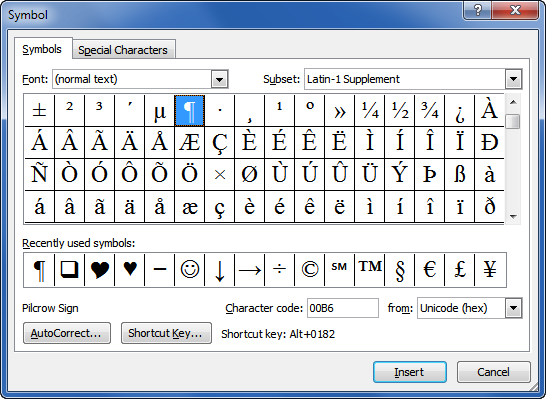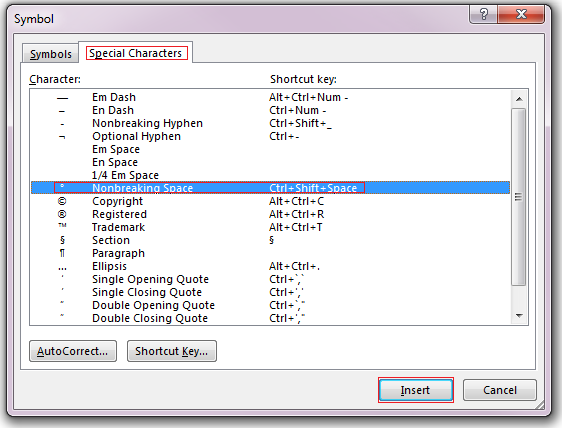

Rules vary from country to country, but in general this particular trademark has no legal significance, and is generally used to dissuade others from using your product name. It’s always worth making sure that trademarks are correctly represented, and using this or the following symbol against trademarked names in your literature (at least at first mention) will ensure that no misunderstandings arise. Mathematicians will also be familiar with the double-prime, but it’s also used to mean inches – so for any of us who might be tempted to use double-quote marks, boost your credentials (at least amongst punctuation pedants) by using the real thing instead. Prime ′ ALT-8242Ī bit like a quote-mark without the curly tail, this symbol is rarely used outside of mathematics – but indispensable within it! Double-prime ″ ALT-8243 Named after Swedish scientist Anders Jonas Ångström, this alternative to 10 –10 m is widely used in materials science.
#Word shortcut keys for symbols code#
When you don’t want to cause confusion by using the computing code * (or resort to a regular letter ‘x’), this keystroke is what you need.
#Word shortcut keys for symbols professional#
This symbol for ‘micro’ is to all intents and purposes exactly the same as the Greek letter mu in all fonts I’ve come across (see above), but whichever code you opt for, it will give your work the professional touch through use of units such ‘µm’ rather than ‘um’. If you’re still writing a letter ‘O’ or ‘o’ and then superscripting it – or even digging out the Romance-language masculine ordinal indicator (º) – then save yourself some time with the keystroke for the proper thing. But in a scientific context, I think it is also an elegant symbol for marking an empty cell in a table (a ‘null value’). However, it is widely used in US textbooks, unspaced, to delineate a parenthetic phrase- as I’m illustrating here-in places where a spaced n-dash – as I’m illustrating here – would otherwise be used. m-Dash - ALT-0151Ĭhances are you may not be familiar with this slightly longer version of the dash. dry ice–acetone), it also doubles-up as a minus sign. Bose–Einstein condensate) and mixtures of chemicals (e.g. 10–20 kg) to multi-person scientific methods (e.g. Ideal for everything from numerical ranges (e.g.

So-called because it’s the same length as a letter ‘n’, this is my most often-used shortcut, largely because I love a good n-dash. The symbols themselves usually look best in a serif font rather than a sans-serif font – I’ve chosen Cambria here.

They also avoid the problem of your symbols changing back to the Roman letters if you later decide to change the font used in your document! These ALT codes for the Greek letters most commonly used in scientific texts will ensure that they’ll appear correctly in most common fonts. But Greek letters are now encoded in many common fonts, so you can achieve a more consistent appearance by using the following ALT codes to generate the symbol instead.

Now that I’ve covered that technicality, here are my top symbols and their shortcuts: Greek lettersįor many years, the go-to method for getting Greek letters was to key the Roman letter, and then laboriously change the font to Symbol (‘a’ for alpha, ‘b’ for beta, etc.). If you’re using a keyboard that doesn’t have a numberpad, then it’s still possible but just a bit more fiddly – while holding the key marked with a coloured ‘Function’ or ‘fn’, press and release ‘Num lock’, and then use the keys that have numbers in the same colour. Most of the shortcuts I’ve listed below use the numberpad – all you need to do is to ensure ‘Num lock’ is on, hold down ‘ALT’, and then key the digits to get the symbol (or ‘glyph’ to use the correct terminology). To help you get started, I’ve selected the symbols that I think are the most useful in scientific literature. Correct use of scientific symbols is essential to make your document look professional – but do you ever wish you didn’t have to constantly scroll down through the Symbol palette looking for your chosen character? If this is a familiar frustration (and you‘re working in a full-capability app such as Word) then it’s worth trying ALT codes instead.


 0 kommentar(er)
0 kommentar(er)
